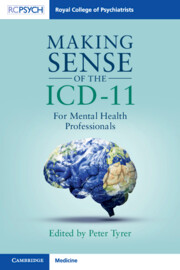Book contents
- Making Sense of the ICD-11
- Making Sense of the ICD-11
- Copyright page
- Contents
- Contributors
- Introduction
- Chapter 1 Development and Innovation in the ICD-11 Chapter on Mental, Behavioural and Neurodevelopmental Disorders
- Chapter 2 ICD-11 + DSM-5 = A Diagnostic Babel
- Chapter 3 Schizophrenia or Other Primary Psychotic Disorders
- Chapter 4 Mood Disorders
- Chapter 5 Disorders Specifically Associated with Stress
- Chapter 6 Disorders Due to Substance Use
- Chapter 7 Child and Adolescent Psychiatric Disorders
- Chapter 8 Anxiety and Fear-Related Disorders and Obsessive–Compulsive and Related Disorders
- Chapter 9 Personality Disorders
- Chapter 10 Disorders of Intellectual Development
- Chapter 11 Eating Disorders
- Chapter 12 Mental Health Classifications in Primary Care
- Index
- References
Chapter 4 - Mood Disorders
Published online by Cambridge University Press: 13 October 2023
- Making Sense of the ICD-11
- Making Sense of the ICD-11
- Copyright page
- Contents
- Contributors
- Introduction
- Chapter 1 Development and Innovation in the ICD-11 Chapter on Mental, Behavioural and Neurodevelopmental Disorders
- Chapter 2 ICD-11 + DSM-5 = A Diagnostic Babel
- Chapter 3 Schizophrenia or Other Primary Psychotic Disorders
- Chapter 4 Mood Disorders
- Chapter 5 Disorders Specifically Associated with Stress
- Chapter 6 Disorders Due to Substance Use
- Chapter 7 Child and Adolescent Psychiatric Disorders
- Chapter 8 Anxiety and Fear-Related Disorders and Obsessive–Compulsive and Related Disorders
- Chapter 9 Personality Disorders
- Chapter 10 Disorders of Intellectual Development
- Chapter 11 Eating Disorders
- Chapter 12 Mental Health Classifications in Primary Care
- Index
- References
Summary
All changes have both good and bad consequences. However, on occasion, some of the ramifications can also be ‘ugly’. In a similar vein to Sergio Leone’s classic , ICD-11 has finally, after 30 years, revised its description of mood disorders. The good things are that they have dispensed with the term ‘affective’, introduced the concept of clusters of mood symptoms, and combined depression and bipolar disorder into a unified spectrum of mood disorders. The bad things are a missed opportunity to fully embrace mixed states and extend some of the innovations that have been applied to depression to its counterparts namely, mania and mixed mood states. However, it is the ugly that is most disturbing, as they have blindly embraced the erroneous concept of subtyping bipolar disorder – a venture that has been a categorical disaster. Queue Ennio Morricone.
- Type
- Chapter
- Information
- Making Sense of the ICD-11For Mental Health Professionals, pp. 39 - 58Publisher: Cambridge University PressPrint publication year: 2023



